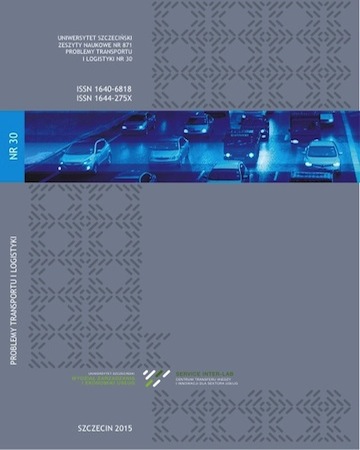
ISSN: 1644-275X
eISSN: 2353-3005
OAI
DOI: 10.18276/ptl.2015.30-06


Issue archive /
ZN nr 871 PTiL nr 30
WYKORZYSTANIE LNG JAKO PALIWA ŻEGLUGOWEGO NA MORZU BAŁTYCKIM – PRZESŁANKI STOSOWANIA, KIERUNKI ROZWOJU ORAZ FORMY WSPARCIA
(LNG AS A MARINE FUEL ON THE BALTIC SEA – APPLICATION, DEVELOPMENT AND FORMS OF SUPPORT)
| Authors: |
Maciej
Matczak
Katedra Systemów Transportowych, Wydział Nawigacyjny Akademii Morskiej w Gdyni |
| Keywords: | shipping LNG terminals and bunkering stations Baltic Sea |
| Data publikacji całości: | 2015 |
| Page range: | 14 (73-86) |
Abstract
The one of the leading priority of the European Union transport policy is a reduction of the external costs of transport. Implementation of the sulphur directive is an example of practical implementation of that priority. Thanks that, a significant reduction of the emissions into atmosphere of sulfur oxides should be achieved. The following technological solutions capable of meeting the directive’s requirements can be pointed out: the use of distillate fuels with reduced sulfur content, introduction of the cleaning systems for exhaust gases (scrubbers) or the implementation of the alternative fuels, including LNG. The LNG is particularly attractive solution because it allows to get the required drop in emissions and similarly to obtain the costs savings in bunkering, especially in the long term. The activity aimed at the improvement of the transport fleet as well as the development of the network of LNG bunkering station has been observed in recent times. Importantly, these initiatives have a broad support from the European Union, therefore further steps towards the implementation of LNG as a marine fuel in the Baltic can be expected. A breakthrough for this process will be year 2015. This is confirmed by a significant increases in the number of orders for ships powered by LNG, as well as new projects of LNG terminals and bunkering stations in the Baltic ports. It could be stated, that “the LNG as the marine fuel” it is not only an attractive political slogan, but also an interesting alternative for the market players.
Download file
Article file
Bibliography
| 1. | Arolski E., LNG in Baltic Sea Ports II, BPO Conference, Ronne, Denmark 5.09.2014. |
| 2. | CMA CGM, Daewoo To Develop LNG-Powered Container Ship, http://shipandbunker.com/news/world/261288-cma-cgm-daewoo-to-develop-lngpowered-containership. |
| 3. | CO2 & Ship Transport emission Abatement by LNG, Valencia Port Foundation, Valencia 20.02.2014. |
| 4. | Costs and Benefits of LNG as Ship Fuel for Container Vessels, MAN Diesel & Turbo 2011. |
| 5. | Fjord Line to have an LNG terminal in Hirtshals, www.baltictransportjournal.com/denmark/fjord-line-to-have-an-lng-terminal-in-hirtshals,1677.html. |
| 6. | Haram H.K., LNG in Europe? ShortSea Shipping NORWAY, www.academia.edu. |
| 7. | Jansson P.O., Arolski E., LNG in the Baltic Sea Ports, INEA meetings, Brussels 9.07.2014. |
| 8. | Komunikat Komisji do Parlamentu Europejskiego, Rady, Europejskiego Komitetu Ekonomiczno-Społecznego i Komitetu Regionów: Czysta energia dla transportu: europejska strategia w zakresie paliw alternatywnych, COM (2013) 17 Final. |
| 9. | Maersk considers LNG as new fuel, http://shippingwatch.com/carriers/article6263287.ece. |
| 10. | Mohn H., An overview of compliance strategy of ship-owners in the SECA area, BPO Conference, Ronne 4.09.2014. |
| 11. | North European LNG Infrastructure Project. Appendix 2, Danish Maritime Authority, March 2012, TEN-T Project, 2010-EU-21112-S. |
| 12. | Riga – geographically and economically the most favorable place for LNG terminal construction, www.baltic-course.com/eng/transport/?doc=41270. |
| 13. | Rozporządzenie Parlamentu Europejskiego i Rady (UE) nr 1315/2013 z 11 grudnia 2013 r. w sprawie unijnych wytycznych dotyczących rozwoju transeuropejskiej sieci transportowej i uchylającej decyzję nr 661/2010/UE, DzU UE L 348/1, 20.12.2013. |
| 14. | Rozporządzeniu Parlamentu Europejskiego i Rady (UE) nr 1316/2013 z 11 grudnia 2013 r. ustanawiające instrument „Łącząc Europę”, zmieniającym rozporządzenie (UE) nr 913/2010 oraz uchylające rozporządzenie (WE) nr 680/2007 i (WE) nr 67/2010, DzU UE L 348/12 |
| 15. | Second IMO GHG Study 2009, IMO 2009. |
| 16. | Skangass builds LNG bunkering solution, www.skangass.com/index.cfm?id=408969. |
| 17. | The Ministry of Employment and the Economy granted EUR 65.2 million in three new LNG terminals, www.tem.fi/en/energy/press_releases_energy 89521_m=116057. |
| 18. | www.bunkerindex.com |
| 19. | www.ferc.gov/market-oversight/othr-mkts/lng/othr-lng-wld-pr-est.pdf. |